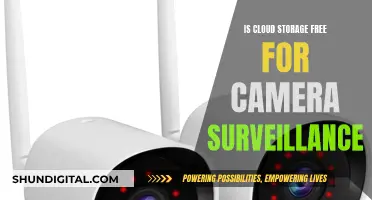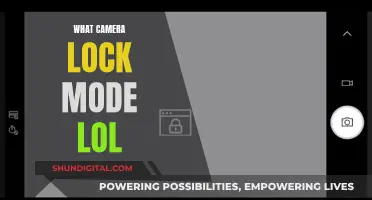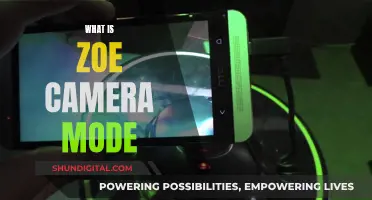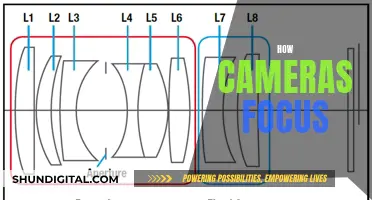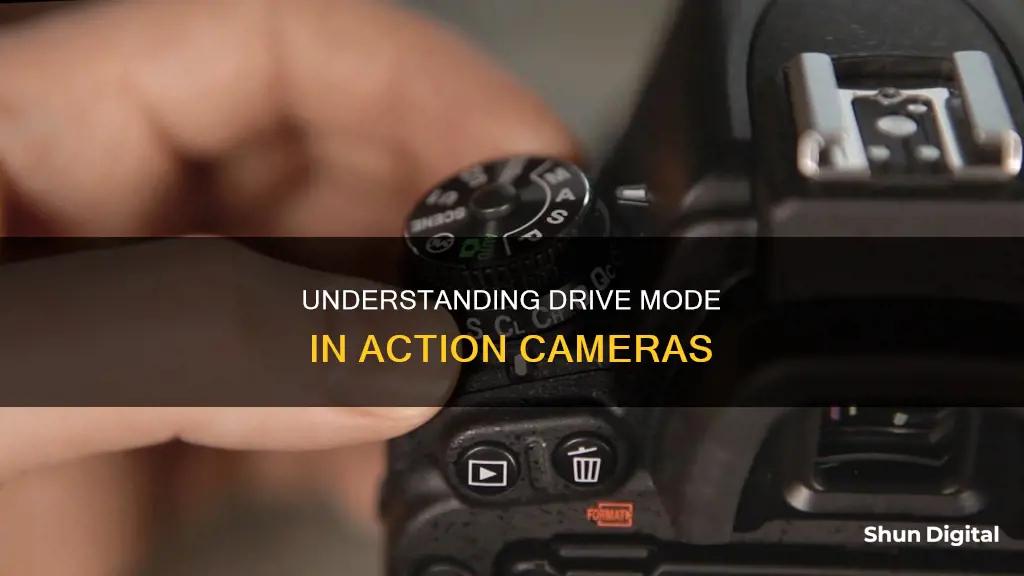
Action cameras are often used as dashcams, but they don't have the same features as a dedicated dashcam. One of the key differences is that dashcams have a driving mode or loop recording function, which allows for continuous recording by overwriting old files. This means that the camera will automatically start recording when powered on and will only store the last few minutes of footage. This is particularly useful for recording driving trips and can be essential for providing evidence in the case of an accident.
What You'll Learn

Loop recording vs. driving mode
Loop recording and driving mode are two different settings available on some action cameras. They are both designed to facilitate continuous recording, but they work in slightly different ways.
Loop recording is a feature that allows your camera to record video continuously in a series of short segments, typically between 1 to 5 minutes in length. Once the storage capacity is full, the camera will automatically begin to overwrite the oldest video segment with the newest one, ensuring that you always have the most recent footage. This eliminates the need for manual deletion or formatting of the memory card, saving you time and effort. Loop recording is particularly useful for dashcams, security cameras, and action cameras, where continuous and uninterrupted footage is essential.
On the other hand, driving mode, also known as "dash cam" mode, usually refers to a single loop that will fill the card and then start overwriting itself. Unlike loop recording, which breaks the video into predetermined segments, driving mode will record continuously until the card is full. Some cameras will set aside a certain amount of space for driving mode, while others will simply overwrite the oldest footage. Additionally, driving mode may also refer to a feature where the camera automatically starts recording when powered on, making it convenient for use in vehicles.
The main difference between loop recording and driving mode lies in the way they handle video segments. Loop recording breaks the footage into smaller, predetermined segments, while driving mode typically records continuously in a single loop. This means that in driving mode, you will have longer video files that need to be manually stopped or cleared, whereas loop recording automatically manages the storage by overwriting the oldest segments.
Both loop recording and driving mode have their advantages and are well-suited for different use cases. Loop recording is ideal for situations where continuous, uninterrupted footage is required, such as in dashcams or security cameras. It ensures that you always have the most recent footage and eliminates the hassle of manual storage management. On the other hand, driving mode can be useful when you want to record a single event or trip without the need for constant recording. It also ensures that you don't run out of storage space as the oldest footage will be automatically overwritten.
It is important to note that the specific functionalities of loop recording and driving mode may vary depending on the camera manufacturer. Some cameras may offer additional features or customizations for these modes, so it is always a good idea to refer to the user manual or the manufacturer's website for detailed information about your particular camera model.
Charging the Wyze Camera: Quick and Easy Steps
You may want to see also

Driving mode and automatic recording
When driving mode is enabled, the camera will automatically start recording when the vehicle is started and stop recording a couple of minutes after the vehicle is switched off. This feature is particularly useful for recording journeys and can be activated by connecting the camera to the vehicle's power supply, such as the cigarette lighter.
Loop recording, which can be used in conjunction with driving mode, will break the video into segments of a predetermined length, such as 3 or 5 minutes. This allows the camera to continuously record by overwriting the oldest files when the memory card is full.
The combination of driving mode and loop recording can be a useful alternative to dashcams, which are cameras specifically designed for cars. While action cameras are versatile and can be used for various purposes, dashcams are more specialised and include features such as automatic recording when the engine is turned on, parking mode, and night vision.
Dashcams are also designed to be inconspicuous, reducing the risk of theft, and can withstand high temperatures in a car on a hot day. In contrast, action cameras may be more noticeable, inviting theft, and may not be able to withstand extreme temperatures.
Therefore, while action cameras can be used as dashcams with the help of driving mode and loop recording, dashcams are specifically designed for this purpose and offer additional features that make them a more convenient and reliable option.
Unlocking Camera Raw: Load Your Presets Like a Pro
You may want to see also

Pros and cons of using an action camera as a dashcam
Action cameras are small, durable, and typically used to record sports. They are designed to be worn on the body or mounted on equipment. Due to their compact size and ease of use, they are also popular for vlogging.
Dash cams, on the other hand, are designed specifically for cars. They record what happens in front of your vehicle and are usually equipped with GPS to track speed and location. They are often plugged directly into the vehicle, so they don't need a battery and can be set to record automatically when you start driving.
Pros of Using an Action Camera as a Dashcam:
- Multi-Purpose: Action cameras can be used for various purposes beyond just being a dashcam, such as vlogging or recording sports.
- Wide-Angle Lens: The wide-angle lens of action cameras can easily cover the entire view in front of your car.
- Easy Installation: Action cameras can be mounted on anything, including the windshield or rearview mirror, making them easy to install in a vehicle.
- High-Quality Recordings: Action cameras have sufficient resolution and image stabilization to provide high-quality recordings, ensuring clear footage in the event of an incident.
- Affordability: Using an existing action camera as a dashcam can be more cost-effective than purchasing a dedicated dashcam.
Cons of Using an Action Camera as a Dashcam:
- Battery Life: Action cameras rely on batteries, which need to be replaced or recharged regularly, especially if you drive frequently. This can result in periods of driving without a camera if the battery is not adequately maintained.
- Manual Operation: Action cameras need to be switched on and off manually for each trip, which is less convenient than a dashcam that automatically starts and stops recording when the engine is turned on or off.
- Theft Risk: Action cameras are often more conspicuous and expensive than dashcams, making them more attractive to potential thieves, which may increase the risk of vehicle break-ins.
- Temperature Sensitivity: Action cameras are not designed for the high temperatures that can be experienced inside a car on a hot day, particularly when stored in direct sunlight.
- Lack of Parking Mode: Action cameras do not have a parking mode that acts as a surveillance camera when the vehicle is parked, which is a feature offered by many dedicated dashcams.
- Night Vision Limitations: While action cameras can be used at night, they are not specifically designed for this, and their recordings may lack the detail and clarity of dedicated dashcams with night vision capabilities.
In summary, while action cameras can be used as dashcams and offer some advantages in terms of versatility and image quality, they also come with several drawbacks. Dashcams, on the other hand, are designed specifically for the task of recording driving footage and offer a range of specialized features that make them more convenient and reliable for this purpose.
Off-Brand Camera Batteries: Overheating Risk?
You may want to see also

Differences in battery life and automatic recording
When it comes to battery life, action cameras have reasonably good batteries, but they fall short when compared to dashcams. Dashcams are designed to be plugged into your vehicle, so they don't run out of battery. On the other hand, action cameras need to be powered by batteries, which means that depending on how often you use the camera, the battery will have to be replaced regularly. This can be inconvenient and may result in you driving without a camera. To extend the battery life of your action camera, you can connect it to an external power supply or battery bank, or carry spare batteries with you.
To address this issue, some action cameras have been designed with in-built batteries, which cannot be removed and replaced with spares. However, this limits your ability to use the camera continuously for extended periods.
In addition to battery life, another important consideration is the automatic recording function. Dashcams are designed to start recording automatically when you start driving and stop when you turn off the engine, making it easy to record every trip without any manual intervention. In contrast, action cameras need to be switched on manually each time you want to start recording. This can be cumbersome, especially if you're using the camera for everyday driving.
While some action cameras offer a "driving mode" or "dash cam mode", this typically refers to a loop recording function rather than an automatic recording feature. Depending on the camera, the driving mode may record a single loop that overwrites itself when the card is full, or it may set aside a certain amount of space for the driving mode and then begin overwriting.
Therefore, if you're looking for a camera with long battery life and automatic recording capabilities, a dedicated dashcam is a better option than an action camera. Dashcams are designed specifically for continuous recording in vehicles and offer features like automatic start and stop, as well as parking mode, which make them more convenient and practical for everyday use.
The Ultimate Camera Companion: Understanding Battery Packs
You may want to see also

Recording duration and memory
The recording duration and memory of an action camera in drive mode can vary depending on the camera manufacturer and the settings selected.
In drive mode, also known as "dash cam" mode, the camera typically records in a continuous loop, overwriting the oldest footage when the memory card becomes full. This loop length can be set to a specific duration, such as 5 or 20 minutes, and the camera will continue recording in loops until it is turned off. Some cameras may also have an option to set aside a certain amount of space for the drive mode, allowing it to record for a longer period before overwriting older footage.
The recording duration and memory usage in drive mode can be affected by factors such as the resolution and quality of the video, the frame rate, and the capacity of the memory card. A higher resolution or frame rate will result in larger file sizes, which will fill up the memory card faster. Therefore, it is important to consider the available memory card space when setting the loop length in drive mode.
Additionally, some cameras may offer features such as smart looping, where the last loop is saved to a file and never overwritten, allowing you to retain specific footage. Other cameras may automatically start recording when powered on, ensuring that you capture important events from the moment the camera is turned on.
It is worth noting that the specific behaviour of drive mode can vary between different camera manufacturers and models. Therefore, it is always a good idea to refer to the camera's user manual or manufacturer's website for detailed information on how the drive mode functions and how to optimise the recording duration and memory usage for your particular camera.
Night Vision Photography: How to Capture the Dark
You may want to see also
Frequently asked questions
Driving mode, also known as dash cam mode, is a loop recording mode. This means that the camera will automatically start recording when it is powered on, and will only keep a certain amount of footage (usually the last 5 minutes) before it starts overwriting old footage.
When driving mode is enabled and the camera is plugged into a power source, it will automatically start recording when the vehicle is started. Recording will stop a couple of minutes after the vehicle is switched off.
In loop recording, the video is broken into segments of a predetermined length (e.g. 3 or 5 minutes). In driving mode, the camera will usually fill the card and then start overwriting itself.
Action cameras are small, durable, and have strong image stabilization. They can be mounted on anything and are often equipped with GPS, allowing them to record a vehicle's speed and location.
Yes, there are several. Action cameras need to be switched on manually every time you want to start recording, and they run on batteries that will need to be replaced regularly. They are also more conspicuous, which may invite theft. Additionally, they do not have parking mode or night vision capabilities like dedicated dashcams.


